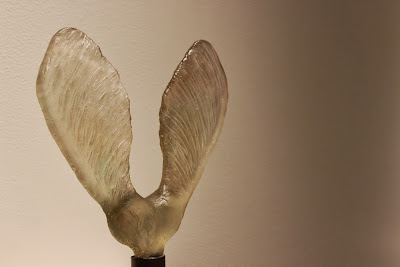.JPG) |
| Sweeney Vase |
Oglebay was a great place to visit, and I would suggest to anyone to come to the area (Wheeling, WV) and interact with the knowledgeable staff. During our time at the museum we were able to learn about the history of Wheeling and how they played not only a key role in glass, but also things like coal, steel, ans such forth. The reason for this being is that Wheeling was central route by the railroad and the national highway. Because of this great location there many thriving glass factories within the limits of Wheeling ans the surrounding area. It was in Wheeling where a chemist from Hobbs Glass designed a new batch of glass that can withstand pressing by machinery, the key ingredient being bicarbonate of soda. We also came across a five foot 200lbs blown glass vase that was created by glassblowers of Sweeney as a showcase. There were a total of three made, but only one survived today and is located in the museum.
The exciting part of the trip was to be able to watch a professional glass blower make a vase from molten glass. There will hopefully be a video posted up shortly once it has been edited.
.JPG)
We also visited Gabbert Cullet in Wiliamstown, WV where they collect glass that will be sorted and shipped to glass blowers across the united states. It's a small operation, but they are still thriving by selling to small glass blowers and larger businesses. The most expensive cullet that is collected is the ruby and the orange colors.
Review my last post about cullet and its use within glassblowing.













.JPG)
.JPG)
.JPG)
.JPG)
.JPG)
.JPG)
.JPG)
.JPG)
.JPG)
.JPG)
.JPG)







.JPG)
.JPG)
.JPG)
.JPG)
.JPG)
.JPG)

.JPG)

.JPG)
.JPG)
.JPG)
.JPG)
.JPG)